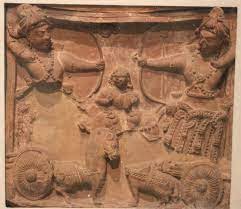Satavahana dynasty, an ancient Indian family, played a significant role in shaping India’s past. The Satavahanas were the most important native successors of the Mauryas in Deccan and Central India. The heart of their kingdom lay in present-day Andhra Pradesh, Telangana, and Maharashtra. But Satavahanas’ influence reached as far as Gujrat, Madhya Pradesh, and Karnataka at different times. At various times, the dynasty established its capital in different cities, such as Pratisthana(Paithan) and Amaravati(Dharanikota). The Puranas referred to them as the Andhras also. From overthrowing the Kanvas to facing foreign invaders like the Shakas, the Satavahanas left an unforgettable mark on Indian history.
Ruling Period:

The ruling period of the Satavahana dynasty is still in doubt. Various types of evidence lead to multiple theories. Some evidence state that this dynasty began between 271 BCE and 30 BCE, and Simuka was the first ruler. On the other hand, some ancient texts (the Matsya Purana and the Indica) suggest that their rule began in the 3rd century BCE.
However, according to modern scholars, the ruling period of the Satavahanas was from the 1st century BCE to the 2nd century CE. This theory is based on the evidence gathered from Puranic records, archaeology, and coins.
Notable Rulers of the Satavahana Dynasty:
Simuka:
King Simuka is mentioned as the first ruler of the Satavahana dynasty in Nanaghat inscription. The Puranas spell the name of the first king of Satavahana lineage in various ways. Experts believe that those are the corrupted spellings of ‘Simuka’. Due to the presence of various contradictory evidence, the exact ruling period of Simuka is still not clear.
Kanha:
According to the Puranas, Kanha was the brother and successor of King Simuka. Besides various Puranas, the Nasik Cave inscription (cave 19) solidified the existence of King Kanha in the Satavahana lineage. The inscription mentions him as ‘Kanha-Raja’ of ‘Satavahana-Kula’ (Satavahana family). It also suggests that King Kanha supported Buddhism. He had an administrative department dedicated to the well-being of Buddhist monks.
Satakarni I:
Most of the Puranas mention Satakarni I as the third ruler of this dynasty. Based on the Nanaghat Cave inscription, Historians conclude that Satakarni I was the son of King Simuka. This inscription describes Satakarni I as ‘Lord of Dakshinapatha’ and tells about his two-horse sacrifices (Aswamedha). As per the Matsya Purana, Satakarni conquered western Malwa from the Sungas. He is also mentioned in the Hathigumpha inscription of Kalinga King Kharvela.
Hala:
According to Matsya Purana, Hala was the 17th ruler of the Satavahana dynasty. Vijayananda was the commander-in-chief of Hala’s army. A successful campaign was executed in Ceylon (modern Sri Lanka) under his command. Lilavai, a Maharashtri Prakit Poem, describes Hala’s romance with the Princess of Simhaladvipa (Ceylon). He was also famous for his literary work in the Prakrit language. King Hala compiled ‘Gaha Sattasai’ (Gatha Saptasati), a great collection of Indian poems in the Maharashtri Prakrit language.
Gautamiputra Satakarni:
After King Sivasvati, Gautamiputra Satakarni ascended the throne of the Satavahana dynasty. Gautamiputra Satakarni was one of the most important rulers in Satavahana lineage. All Puranas (Except Brahmanda Purana) with the Satavahana lineage mention Gautamiputra. We get enormous information about Gautamiputra from his coins and the Satavahana inscriptions. Among those, the Nasik inscription (cave-3) of his mother is the best one to know about Gautamiputra.
According to Nasik inscription, Gautamiputra defeated the Western Kshatrapas (Shakas), the Indo-Parthians (Pahlavas), the Indo-Greeks (Yavanas), and revived Satavahana power. His rule covered a vast area, stretching from Malwa and Saurashtra in the north to Krishna River in the south. It also extended from Konkan in the west to Vidarbha in the east. Despite having no strong evidence, some historians suggest that Gautamiputra may have conquered the Cholas and the Pandyas in southern India. He is mentioned as ‘King of kings’ in this inscription.

Vasishthiputra Pulumavi:
Vasishthiputra Pulumavi, son of Gautamiputra Satakarni, was another important ruler of the Satavahana dynasty. Paithan was the capital of Pulumavi. He ruled during the early 1st century CE. Some of his lead coins carry the depiction of a two-masted Indian ship. Those depictions show Satavahanas’ seafaring and trading prowess during the 1st -2nd century CE. The Nasik caves inscription (cave-3) and Karla caves inscription also mention Vasishthiputra Pulumavi. After him, Vashishthiputra Satakarni ascended the throne.
Yajna Sri Satakarni:
Yajna Sri Satakarni was the successor of his brother Vashishthiputra Satakarni. He is considered the last successful king of the Satavahana dynasty. Yajna Sri Satakarni won back some of the lands from the Western Satraps (Shakas). He also beat them and got back to the southern areas of western and central India. After him, the Satavahana dynasty began to weaken. Yajna Sri Satakarni was most probably the 27th ruler of Satavahana lineage.
There is a controversy about the last king of this lineage. However, most experts suggest that Pulumavi IV was the last ruler of the Satavahana dynasty and ruled till 225 CE. After his death, the empire split into five smaller kingdoms.
Some Important Facts about the Satavahana Dynasty:
Religion-
The Satavahanas were followers of Hinduism and claimed Brahmanical status. They were also quite generous to Buddhist monasteries, showing their support for Buddhism. It indicates that people of the Satavahana period didn’t strongly favor a particular religion.
Language:

The Satavahanas had a mix of languages in their historical records and coins. The use of a Middle Indo-Aryan language is seen in their inscriptions and coins. Some experts have termed this language ‘Prakrit‘.But in ancient texts, the language is closer to ‘Sanskrit’ than the Prakrit. Another language, called ‘Desi’ was also used in that period. Their coins dazzled with bilingual designs- one side in Middle Indo-Aryan and the other side in Desi.
Economy:
During the Satavahanas’ reign, agriculture served as the primary foundation of their economy. They boosted their economy by farming, making more goods, and trading within and beyond India.
Cultural Achievements:
Most inscriptions of the Satavahana period focus on individual donations to Buddhist monasteries. They provide limited information about the dynasty. These inscriptions are in Brahmi script.
The architectural brilliance of the Satavahana dynasty is reflected through their construction of various Buddhist stupas. They built impressive Buddhist stupas like the 95-foot-high Amaravati Stupa. Satavahanas also constructed many stupas in places like Goli, Jaggiahpeta, Gantasala, etc.
The Satavahana paintings are found at the Ajanta Caves are the earliest surviving artworks (excluding pre-historic rock art) in India. Unfortunately, natural forces and vandalism have damaged many of these. Only a few remnants related to Satavahanas have survived in Caves No. 9 and 10. Both are Chaitya-grihas with stupas. The most significant surviving painting from this era is in cave no. 10. This painting depicts an elephant named Bodhisattva with six tusks.
People also Read : Ajanta caves-A remarkable UNESCO World Heritage Site
Despite its mysterious reign, the Satavahana dynasty remains a vital chapter in Indian history. They were not only skilled rulers but also early issuers of Indian state coinage. They also acted as cultural intermediaries between North and South India. Furthermore, the Satavahanas’ contributions to art, trade, and religious practices continue to resonate in the present day.


Pingback: Kanva Dynasty : A Forgotten One - India Insights
Pingback: Shunga Dynasty Facts: Everything You Need to Know - India Insights
Pingback: Hathigumpha Inscription: A Fascinating Tale of a Jain King Kharavela - India Insights
Pingback: Nanaghat Inscription of The Satavahanas - India Insights